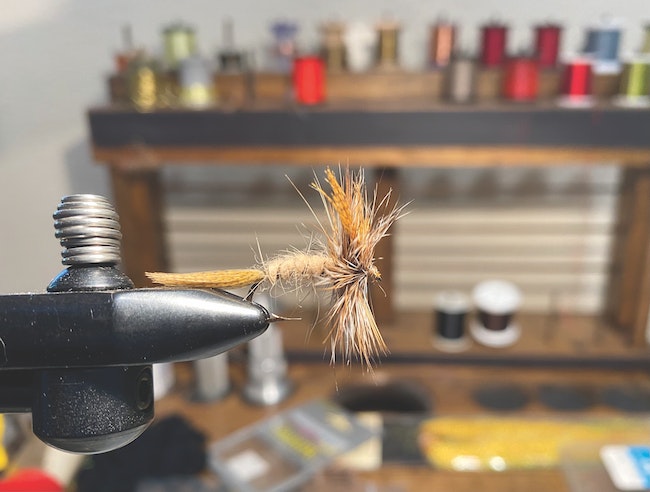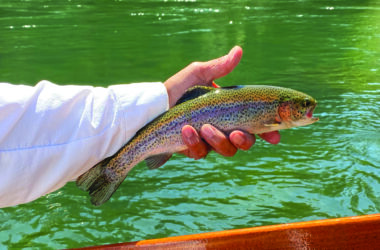 FRANK ARMENDARIZ/CHRONICLE PHOTO – The emergence of the March brown mayfly on the McKenzie and other rivers in the Willamette valley marks the start of the fly fishing season in western Oregon. The March brown is a hardy mayfly that prefers to emerge on cool and blustery days.
FRANK ARMENDARIZ/CHRONICLE PHOTO – The emergence of the March brown mayfly on the McKenzie and other rivers in the Willamette valley marks the start of the fly fishing season in western Oregon. The March brown is a hardy mayfly that prefers to emerge on cool and blustery days.
It’s not exactly like clockwork, but it’s pretty dependable … every year as the daylight hours equalize with the night, things emerge, sprout and in general come alive in the Willamette Valley. Daffodils, crocus and daisies begin to color the valley’s floor and on the banks of our rivers the dogwood willows become bright red, the cottonwoods, and maples are budding and all will soon be lush with spring foliage …
Also stimulated by the growing daylight are the aquatic insects that inhabit the Willamette Valley’s many river systems. After spending the winter on the river bottom, mayfly species are the first to emerge. Caddis are next; they are usually present on the McKenzie and Willamette by late April and May, followed by a variety of small stone flies and a bunch of other terrestrials by June.
In the McKenzie and most every other river, caddis are the most common aquatic insects and the most prolific of the aquatic insects that live in our rivers. They naturally occur in a variety of colors including cream, yellow, brown, orange, and black, and emerge in what is commonly referred to as a “cloud of caddis.” In general, aquatic insects transition through the winter from a larva, to a nymph. In the nymph stage they browse the river bottom, feeding on a variety of freshwater arthropods and other microbes, then emerge as winged insects in the early spring to breed and the activity continues through summer. The key stimulus is always the sunlight, although general weather can affect aquatic insects and their emergence in the short term.
Multiple species of mayflies also inhabit our rivers, although in the upper Willamette basin they are not nearly as numerous as caddis. Arguably the two key mayfly species are the “blue winged olives” and the “March browns.” Blue winged olives emerge all year and trout feed on them year-round. Even in the dead of winter, blue winged olives can be found in the quiet eddies along the river banks. But you will seldom find trout rising to the surface to feed on them, but rather intercepting them right underneath the surface. One last point about blue wings: they don’t hatch and emerge in clouds like caddis and other mayfly species, but in small localized bunches that are often overlooked by anglers.
On the other hand, “March brown mayflies” are prolific and emerge by the millions each spring. On our local trout streams they begin their emergence around the spring solstice. The March brown emergence also sets the stage for the coming trout fishing season and consistently brings trout to the surface to actively feed for the first time each season. And when trout start “looking up?” Well, that is the beginning of the fly fishing season in the Willamette valley. One of the earliest trout fishing opportunities in the nation.
In general, all the rivers in the ODFW’s Willamette zone are open year-round for catch-and-release trout fishing but are closed to the use of bait, like worms, salmon eggs, power bait, etc. from November until May; flies and lures are allowed year-round. And fortunately for local anglers, the Willamette River from Harrisburg to Oakridge and the entire length of the McKenzie, are trout central. With strong populations of wild trout, the early spring fishing can be very good. In the spring you will find good river fly fishing conditions when the Willamette is 4.5 feet and falling on the Harrisburg river gage, and on the McKenzie, at 3 feet and falling on the Vida river gage.
Hatchery trout, released primarily into the McKenzie, don’t hold over the winter well and won’t be planted again until May. So in the early spring fishing is entirely a wild trout C&R experience. As one of the west’s best early prospects, the early trout fishing has been popular over past seasons, giving local anglers a chance to shed the effects of cabin fever, but it also attracts fly anglers from all over the world.
***
I was fishing on the Umpqua River last fall and had caught a nice hatchery coho when my party decided to take a shore break at the city boat landing in Reedsport. There is a convenient dock, a nice little park with picnic benches and that day a gentleman was having lunch and I asked how the fishing had been? He said “good.” … We chatted for a moment and he explained that he was restarting an old radio station and was looking for a person to do a fishing report a few days a week. Then out of the blue, he asked, “Would you have any interest in being on the radio?” A few days later I met with the station owner, a radio Hall of Fame broadcaster Delilah Rene, whose radio show is heard on 180 stations and on iHeartRadio, and the program manager, who’s on-air name is Smokey Rivers and is also a Hall of Fame broadcaster. The gentleman at the park, his name is Craig Rurak. A radio station start-up specialist who has consulted on the start-up or rehabilitation of dozens of radio stations across the nation. To make a long story short, please catch my radio show, “Sunrise in the Outdoors,” on Monday, Wednesday, and Friday, at 8:20 a.m. on KDUN 1030 AM, also at kdunradio.com or ask your smart speaker to play KDUN radio on iHeartRadio.
Email: [email protected]








